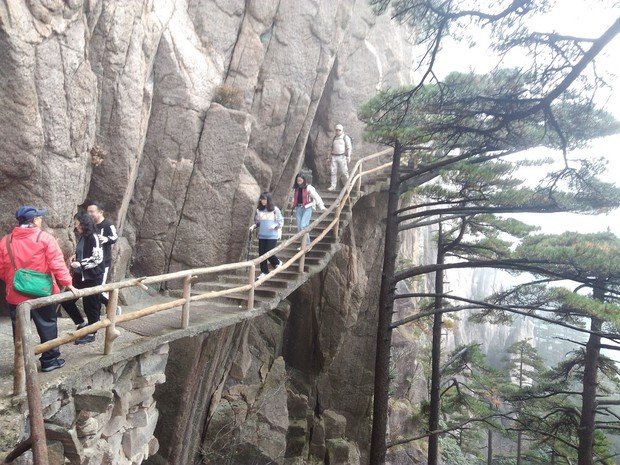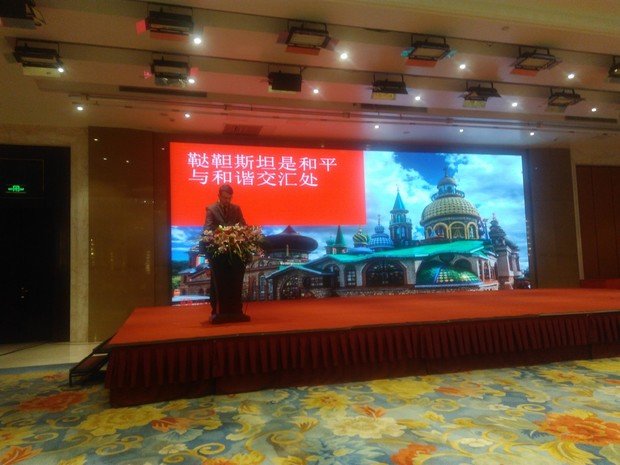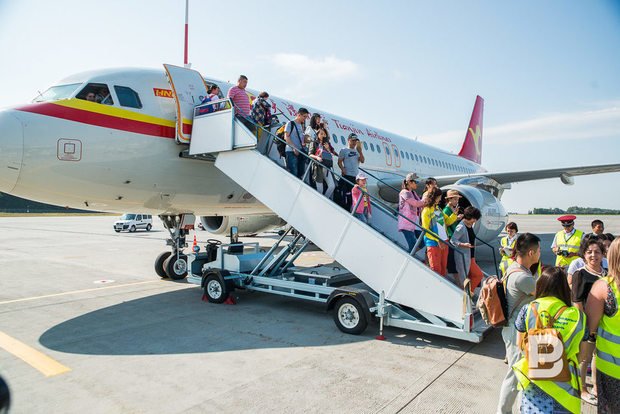Notes from China: what does Anhui Province want from Russian Volga Region?
Kazan — Hefei: flights to Tatarstan, reimbursed yuans and Chinese ideas about the Russian village
The correspondent of Realnoe Vremya has spent several days in the Chinese province of Anhui, where he and his colleagues from the Volga Federal District, Russia, got acquainted with the tourist potential of the region. Our journalist travelled to China as part of the Fourth joint working group of representatives of the the Russian Federation subjects to study the cooperation with the province of Anhui. Read about what China wants to offer Russian partners and what they expect from the regions of the Volga Region in the review of our online newspaper.
Half of Russia, two Tatarstans or one Bashkiria
Probably few Russians have heard about the province of Anhui and its administrative centre — the city of Hefei. Although many have seen photos of mountain and rural landscapes, but did not know what province it was. However, according to its indicators, the region is among the leading administrative territories of the People's Republic of China. Probably, to fill this information vacuum regarding Hefei and its environs, the provincial authorities for the fourth year in a row have organized a visit of representatives of authorities, tourism industry and media from a number of Volga Region cities and St. Petersburg within the framework of the Volga-Yangtze cooperation programme. In fairness, they managed to effectively present their land.
The largest delegations were from the Republic of Tatarstan and Samara Oblast — five people in each of them. From other regions there were from one to three people. We dare to assume that the reason is that Anhui officials intend to develop deeper relations with particularly Kazan and Samara. Tatarstan was represented by Deputy Chairman of Tatarstan State Committee on Tourism Artur Abdrashitov, Director General of the Tourist Information Centre of Kazan Natalia Abramovich, Director for Strategic Development of the Kazan International Airport Veronika Aktasheva, businessman-hotelier Richat Gusamov (Chibis hotel chain) and your present correspondent as a representative of mass media. There were also delegates from Nizhny Novgorod Oblast, Ulyanovsk Oblast, Kirov Oblast, Mordovia and St. Petersburg.
A few words about the region. Anhui is located in the eastern part of China in the middle and lower reaches of the Yangtze River. Let us remind that it is the eastern China is the most industrially developed and densely populated macroregion. According to various socio-economic indicators, Anhui is among the leading regions of the country. The population of the province is more than 70 million people. The area is 139,600 sq. km — comparable area with two Tatarstans (68,000) or one Bashkortostan (143,000). Thousands of kilometres of roads, railways (including high-speed), five airports, river ports connect the province with other cities in China and abroad. Moreover, Hefei, which is home to 7 million people, intends to increase international routes to the CIS countries. Anhui Province has well developed mechanical engineering (Chery, JAC, Cima), metallurgy, cement production (Conch), household appliances, electronics. Various tourism industries are also actively developing. There are offices of 150 foreign companies, 80 of them are among the 500 largest companies in the world.
Let us dwell on the most interesting, from our point of view, offers of the Chinese side.

Reimbursing every yuan spent
One of the important points was the presentation of the tourism potential of the province. Actually, this was the purpose of the trip. The guests from Russia had the opportunity to experience everything that the Chinese side was offering. As Director-General of Anhui Provincial Foreign Affairs Office Sun Yong told, the tourism industry of the region began to develop after the reforms of Deng Xiaoping. If by the beginning of the 1980s, tourism had been the weakest industry in the region, now this sector employs about 10 per cent of the population.
It should be noted that the infrastructure here is arranged very well. For example, one can get quickly from Beijing to Hefei not only by air, but also by high speed and quite comfortable train in literally 3 hours – although it is about 1,000 km. There are also the abundance of hotels of different star-rating, food service companies and travel agencies, offering numerous routes. The scenic mountains, Mount Tianzhu and Huangshan, are equipped with cable car, paths, walkways, terraces and stairs. By the way, none of the Russian delegates had seen such improvement in the mountainous area before.
In addition to beautiful mountains, reminding the landscapes from Avatar film, Anhui inhabitants invites you to immerse into rural life and visit a commune. The authentic village of Hongcun, which is a UNESCO world heritage monument, is known throughout the world. The Internet is full of the photos of the pond and unique buildings of the settlement. The locals offer to buy souvenirs of local production.
Also, the province offers the resort and health tourist services (spa centres, fitness yoga), sports, cultural, industrial (visiting car factories and test drive) and gastronomic ones. A local highlight — smoked perch, Gujing Gong Jiu vodka (52 degrees) and, of course, tea.
''Out of 10 varieties of tea produced in China, four are grown and prepared in our province. Tours to tea plantations with tasting this drink are also provided,'' Mr. Yun emphasizes. Perhaps the most famous is black tea (the Chinese call it red) — Keemun. It is worth noting that tea, even by Chinese standards, is not cheap there. But tasting this tonic drink is always worth it.

According to the head of the committee on tourism of the province, Anhui plans to develop global destinations, thereby expanding the borders beyond its region and country. Besides, the leadership of the region intends to further integrate tourism into various spheres — industry, agriculture, health, culture, education. The authorities include these new formats in the five-year plans (China preserves five-year plans, which Homo Sovieticus still remembers).
The Chinese are carefully studying the experience of other countries where the tourism industry is well developed, and if possible adopt best practices — for example, from how Turkey uses its tourism potential. Moreover, the regional government spends a lot of money on promotion and advertising. The province hosts more than 1,300 tourism events per year. The head of the committee is sure that each yuan spent will be reimbursed multifold soon.
Will people fly from Hefei to Kazan?
At the same time, China is interested in developing tourist destinations to Russia. A direct flight from Hefei to Moscow (once a week) is expected to be launched soon (presumably, on 7 December), which will increase the tourist flow in both directions. As Sun Yun told Realnoe Vremya, if the beginning is successful, the provincial authorities are ready to consider other destinations, including Kazan.
China invited representatives of the Volga region to present the tourism potential of their regions to learn more about Russia. It should be noted that delegates from Samara, Saransk and Nizhny Novgorod in the course of their speech to some extent touched the topic of successful holding of the World Cup in their cities and the infrastructure built for the World Cup. Artur Abdrashitov also mentioned the 2018 World Cup, of course, but, fortunately, Tatarstan, apart from Kazan and its attractions, has something else to show — Bolgar, Sviyazhsk and other interesting attractions. We should pay tribute to our speakers: many prepared their graphic and video presentations in English and Chinese, for which the audience was particularly grateful.
The organizers invited about two hundred heads of tour agencies and officials in charge of the industry for the presentation of the Russian regions. After mutual acquaintance, they exchanged contacts, and the first agreements between the parties were signed.

Veronika Aktasheva and Artur Abdrashitov had quite a long talk with the marketing director of Anhui Civil Aviation Airport Group Co. Ltd., Qin Jun, and his deputy Song Hao. By the way, the air hub of Hefei plans to receive 10 million passengers this year (an increase of 27 per cent compared to last year), the Kazan International Airport — up to 3,2 million people. Despite the seemingly modest performance in comparison with the Chinese giant, the Kazan airport ranks first in the country in terms of passenger traffic.
The representative of Kazan reminded that Tatarstan had a successful experience of air communication with China — with the city of Ürümqi, the capital of Xinjiang Uygur Autonomous Region. The flight load was almost full. Aktasheva makes little secret of that Kazan citizens intend to secure a footing in the market of China. Now, in her opinion, it would be great to establish air communication with Hefei — either a direct flight or a connecting flight in Siberia.
The Chinese vis-a-vis answered that their airport opens new directions not very quickly.
''Tatarstan is certainly an important partner for us — it is a dynamically developing region of Russia. I understand that the prospects for cooperation between our province and your republic are enormous. If the launch of the flight to Moscow is successful, we will consider Kazan as one of the priority destinations. The main thing that matters is to ensure passenger flow. It is also important for us that Tatarstan citizens fly this flight,'' he said.
The most optimal time to start the flight is summer, when in Russia there are warm days, the period of holidays and vacations begins, respectively, it is the peak of passenger traffic. Abdrashitov added that before the launch of the charter flight, his department in Tatarstan and colleagues in Anhui need 3-6 months to carry out an information campaign for the citizens.
In the end, the parties agreed to develop a detailed scheme of interaction and calculate the potential passenger traffic taking into account mutual wishes. Saying goodbye, Veronika Alexandrovna invited her Chinese colleagues to Kazan to study the possibilities of the cooperation and promised to organize a meeting with representatives of airlines ready to take on this project. How successful the interaction of airports will be — we learn in the near future. Let's hope it works out.

Russian village in the Chinese view
The authorities of Anhui proposed a very interesting and somewhat ambitious project was proposed to Russians — the complex 'Russian village'. They are planning to locate it in the vicinity of the city of Qianshan on the picturesque slopes of Tianzhu Mountain, near the Institute of Qigong and Wushu. First, the organizers showed the guests the place for the future construction, the next day talked about it with the Russians. As explained by local officials, the project was discussed by the governor of the province and the minister for the development of the Far East (at that time Alexander Galushka) as an example of cooperation between China and Russia.
As the deputy mayor of Qianshan District said, the village is expected to be built in 2-3 years. A cultural and leisure centre, street with shops and restaurants, cultural centre and mini-hotels will be built on the territory of more than 4,500 square metres. All buildings are planned to be built in the Russian style (as it is understood by Chinese architects). This complex will accommodate 1,000 people. The project is expected to cost 100 million yuans (almost 1 billion rubles). The construction will be in three stages.
The first question to arise was: who is this village designed for?
''This village will be of interest primarily to Russians, then Chinese and tourists from other countries,'' said the deputy head of the economy department of the Foreign Affairs Office of the People's Government of Anhui. Later, the official added that the complex is created not only as a tourist site, but also as a platform for cultural and humanitarian cooperation between the two countries.
The Chinese are offering Russian investors several forms of partnership: in construction, management (''We build, you manage'') and organization of travel agencies. Moreover, if the investor forks out 50 million yuans and more, he will receive the land for construction free of charge and significant tax breaks will be made in the first years of operation.
As it turned out, Chinese companies (in particular, from Harbin) are already ready to invest in this project, but municipal and regional authorities are waiting primarily for Russian investors, ''so that everything was done in Russian style''. Therefore, they listened with interest to the comments and suggestions of the guests, promising to finalize it.
''The conditions for investment are really attractive,'' said Head of the Tourism Department of the Samara Oblast Mikhail Maltsev, who headed the Russian delegation. ''On our part, we guarantee information support on the territory of our regions in order to convey all the above said to potential partners.''
To be continued
Reference
Realnoe Vremya editorial board expresses gratitude to the Anhui centre for cooperation between China and Russia, the Office of Foreign Affairs of the People's Government of Anhui Province and the State Committee of the Republic of Tatarstan on Tourism for organizing the trip to China